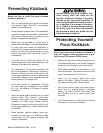
-14-
Model G0690/G0691 (Mfg. 11/10+)
The following is a list of common definitions, terms and phrases used throughout this manual as they relate
to this table saw and woodworking in general. Become familiar with these terms for assembling, adjusting
or operating this machine. Your safety is VERY important to us at Grizzly!
Arbor: A metal shaft extending from the drive
mechanism that is the mounting location for the
saw blade.
Bevel Edge Cut: A cut made with the blade tilted
to an angle between 0˚ and 45˚ to cut a beveled
edge onto a workpiece. Refer to Page 42 for
more details.
Blade Guard Assembly: Metal or plastic safety
device that mounts over the saw blade. Its func-
tion is to prevent the operator from coming into
contact with the saw blade. Refer to Page 37
for more details.
Crosscut: Cutting operation in which the cross-
cut fence is used to cut across the shortest
width of the workpiece. Refer to Page 41 for
more details.
Dado Blade: Blade or set of blades that are used
to cut grooves and rabbets. Refer to Page 59
for more details. The saw and arbor are not
intended to safely use a larger dado blade.
Dado Cut: Cutting operation that uses a dado
blade to cut a flat bottomed groove into the face
of the workpiece. Refer to Page 42 for more
details.
Featherboard: Safety device used to keep the
workpiece against the rip fence and against
the table surface. Refer to Page 50 for more
details.
Kerf: The resulting cut or gap in the workpiece
after the saw blade passes through during a
cutting operation.
Kickback: An event in which the workpiece is
propelled back towards the operator at a high
rate of speed.
Non-Through Cut: A cut in which the blade does
not cut through the top of the workpiece. Refer
to Page 33 for more details.
Parallel: Being an equal distance apart at every
point along two given lines or planes (i.e. the
rip fence face is parallel to the face of the saw
blade).
Perpendicular: Lines or planes that intersect and
form right angles (i.e. the blade is perpendicular
to the table surface).
Push Stick: Safety device used to push the
workpiece through a cutting operation. Used
most often when rip cutting thin workpieces.
Refer to Page 53 for more details.
Rabbet: Cutting operation that creates an L-shaped
channel along the edge of the workpiece. Refer
to Page 45 for more details.
Rip Cut: Cutting operation in which the rip fence
is used to cut across the widest width of the
workpiece. Refer to Page 40 for more details.
Riving Knife: Metal plate located behind the
blade. It maintains the kerf opening in the wood
when performing a cutting operation. Refer to
Page 39 for more details.
Straightedge: A tool used to check the flatness,
parallelism, or consistency of a surface(s).
Thin Kerf Blade: A blade with a kerf or thickness
that is thinner than a standard blade cannot be
used on this saw.
Through Cut: A cut in which the blade cuts com-
pletely through the workpiece. Refer to Page
33 for more details.
Glossary of Terms


















